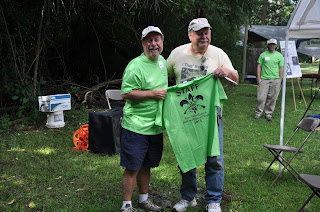 |
| The uncut ribbon leading to the excavation units |
Want to
learn more about 18th-century New France? Then come to the Fort St. Joseph
Archaeological Project's Open House! Visitors will have the opportunity to view
an archaeological site, interact with real life archaeologists and engage in a
variety of activities, reenactments, and educational lectures related to
foodways in 18th-century New France.
The
schedule for the stage is as follows:
Saturday
 |
| Site tours will be lead by the field students |
10:00 am -
Open
10:30 am - Michael Nassaney, "Welcome to the Open House"
11:00 am - Noel Bash, "Colonial Dance" (presentation)
11:45 am - Terry Martin, "Fort St. Joseph Foodways"
12:30 pm - Terry Sorchy, "Person of the Past"
1:15 pm – Noel Bash, "Colonial Dance" (presentation)
2:00 pm - Michael Nassaney "Fort St. Joseph Archaeology"
2:30 pm - Noel Bash, "Dance in the 18th-Century" (talk)
3:00 pm - Noel Bash, "Colonial Dance" (presentation)
3:30 pm – Yve Perez, "Native American Foodways"
4:00 pm - Close
10:30 am - Michael Nassaney, "Welcome to the Open House"
11:00 am - Noel Bash, "Colonial Dance" (presentation)
11:45 am - Terry Martin, "Fort St. Joseph Foodways"
12:30 pm - Terry Sorchy, "Person of the Past"
1:15 pm – Noel Bash, "Colonial Dance" (presentation)
2:00 pm - Michael Nassaney "Fort St. Joseph Archaeology"
2:30 pm - Noel Bash, "Dance in the 18th-Century" (talk)
3:00 pm - Noel Bash, "Colonial Dance" (presentation)
3:30 pm – Yve Perez, "Native American Foodways"
4:00 pm - Close
 |
| See what has been discovered this year |
Sunday
10:00 am - Open
10:30 am - Michael Nassaney, "The Discovery of Fort St. Joseph"
11:00 am - Noel Bash, "Colonial Dance" (presentation)
11:45 am - Terry Martin, "Animals at Fort St. Joseph"
12:30 pm - Noel Bash, "Colonial Dance" (presentation)
1:15 pm - Jeff Pavlik, "An 18th-Century Baker"
2:00 pm - Michael Nassaney "The Future of Fort St. Joseph"
2:30 pm - Noel Bash, "Dance in the 18th-Century" (talk)
3:00 pm - Noel Bash, "Colonial Dance" (presentation)
3:30 pm - WMU Student Archaeologist "Experiences on a Dig"
4:00 pm - Close






